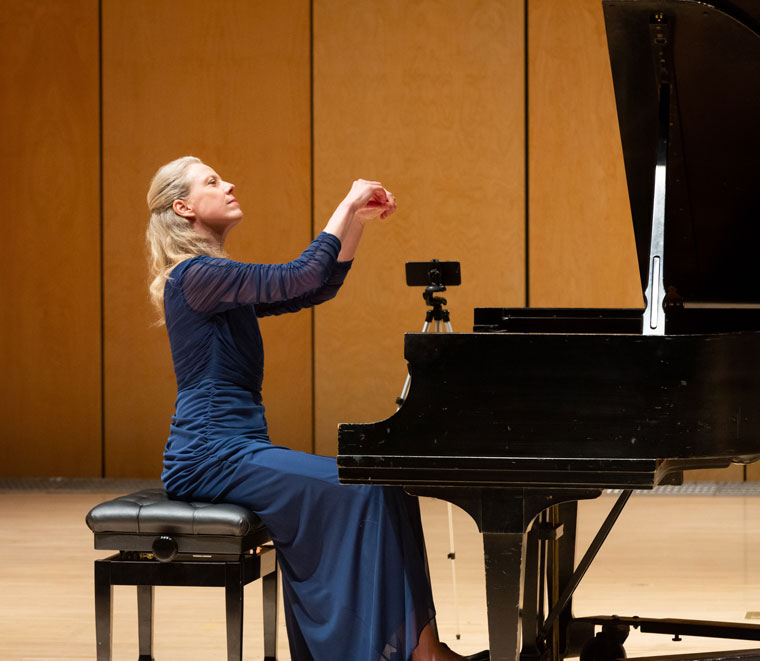
What with the preceding weeks of cold, blustery rain and snow here on the Hill, it would seem somewhat adverse for a recitalist to present a public program dealing in the main with (possibly) equally adverse weather conditions.
Nevertheless, the presenter in question, guest pianist Caroline Oltmanns, acquitted herself of the task quite well on Monday, March 4, in Lowman Concert Hall on the Idyllwild Arts campus, and though her audience was few in number (perhaps in anticipation of further inclemency), the concert was much appreciated in both execution as well as formal design.
Beginning with probably the best-known piece in Leos Janacek’s 15-movement piano suite, based on his native Czech folk melodies for the most part (the overall title itself coming from a Moravian folk tune), Ms. Oltmanns’ interpretation of “On an Overgrown Path (Po zarostlem chodnicku), #2: A blown-away leaf (Listek odvanuty)” seemed to suggest that the “leaf” being blown was more manuscriptive than arborial in nature, at least to this listener; the wind in this case being the slow and fast flow of memory concerned, and regarding the content of the page (perhaps a missing sheaf of music manuscript, or a lost love letter?) as better left in the auditor’s imagination. as the varied dotted rhythms flew by, either quickly or slowly at the whim of both composer and interpreter.
In her introduction to Beethoven’s Sonata #17, Opus 31 #2, D Minor (“Tempest”) which followed, Ms. Oltmanns referred to the story of the composer’s brief injunctive exegesis of that work: “Read Shakespeare’s ‘Tempest,’” not as a case explanation, but as an indication that more is involved here than mere tone-painting; indeed, those critics who can identify themes associated with the characters of the drama (Prospero, Miranda, Caliban, etc) have a hard time unifying the whole of the composition through these parts.
For her efforts, our soloist was valiant in her coalescence of the disparate elements of the sonata’s first movement (tempi, volumes, etc), keeping the vicissitudes to a required minimum, and then restoring a sense of calm in the second movement, and rounding out the rondo finale with a more than requisite balance between the repeated theme and the several episodic outbursts, whether deemed “tempestuous” or not.
After a short pause, Ms. Oltmanns returned to her instrument with a remarkable traversal of selected piano preludes of Claude Debussy, each having to do with the effect of wind in nature.
Her minimal approach emphasized not so much the composer’s impressionistic qualities as much as the actual events implicit in these brief explorations; the wind on the field of heather, the billowing and rustling of sails, and the rough seas the Western wind had to pass over were all present in the delicate fingering and judicious pedaling exhibited.
Following the short interruption of Sinding’s ever popular “Rustle of Spring” (perhaps inserted as an “eye” for the coming storm, and played in as “popular” a manner as possible), Ms. Oltmanns essayed two of the more dramatic pieces from the Franz Liszt portfolio: his solo piano arrangement of the Schubert/Goethe “Earl-King” and the “Storm” from the first book of the “Years of Pilgrimage.”
The drama involved in both pieces was similar; the action of the father and son riding through the wind and rain, as well as the description of a Swiss mountain storm (as can only occur in Switzerland) was complemented in her energetic fingered responses to the required action; such action as would have been exhausting to many a performer, but with the appropriate instinct of both timing and force, such mechanisms were brought to the fore to evince the necessary timed effect, as well as to avoid a total collapse at the end. And in conclusion, Ms. Oltmanns returned to the Debussy Preludes as an encore presentation as a summation of the proceedings (with “Le vent de la plaine” (The Wind on the Plain), Book I, #3), in effect an illustration of the benefits of air and earth (as a contrast to our Hill’s preoccupations with fire and water), and as a promise of better and more beneficial effects of natural elemental mixtures.






